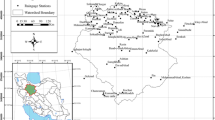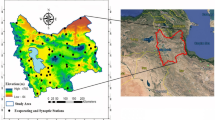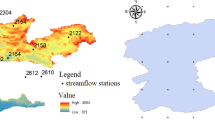Abstract
Drought is one of the most complex and least understood climate-related natural hazards. Active drought mitigation and contingency plan formulation often require a reliable drought distribution map. This study analyzed different spatial interpolation techniques to produce drought distribution map in East Texas, USA. Deterministic [inverse distance weighting (IDW) and spline], and geostatistical [ordinary kriging (Gaussian (KG) and spherical (KS))] interpolation techniques were employed as candidate methods for evaluation. Thirty-four years (1980–2013) of weather station data (N = 47) were used to calculate a 12-month Standardized Precipitation Evaporation Index (SPEI). The dataset was randomly divided into test data (70%, N = 33) and validation data (30%, N = 14). The resulting SPEI maps were cross-checked and validated through a validation dataset by calculating error matrices. The results indicate that KG tends to perform well in relatively drier conditions while IDW shows mixed results, performing well both in dry and wet conditions. The overall power of the four techniques to map 12-month drought conditions resulted in the order of IDW > KG > KS > spline.





Similar content being viewed by others
References
Ali, M. G., Younes, K., Esmaeil, A., & Fatemeh, T. (2011). Assessment of geostatistical methods for spatial analysis of SPI and EDI drought indices. World Applied Sciences Journal, 15, 474–482. https://doi.org/10.1002/joc.1691.
Hagman, G. (1984). Prevention better than cure: Report on human and natural disasters in the third world. Stockholm: Swedish Red Cross.
Palmer, W. C. (1965). Meteorological drought. Research paper no. 45. Washington, DC: US Department of Commerce Weather Bureau.
Mckee, T. B., Doesken, N. J., & Kleist, J. (1993). The relationship of drought frequency and duration to time scales. In Proceedings of the 8th Conference on Applied Climatology (Vol. 17, pp. 179–183). Boston, MA: American Meteorological Society.
Vicente-Serrano, S. M., Beguería, S., & López-Moreno Juan, I. (2010). A multiscalar drought index sensitive to global warming: The standardized precipitation evapotranspiration index. Journal of Climate, 23, 1696–1718. https://doi.org/10.1175/2009JCLI2909.1.
Alley, W. M. W. (1984). The Palmer drought severity index: Limitations and assumptions. Journal of Climate and Applied Meteorology, 23, 1100–1109.
Johnson, S. (2010). Drought Indices for the Regional Drought Decision Support System (RDDSS). Memo (External Correspondence). Houston Engineering Inc. File 4875-009 (pp. 1–12).
Guttman, N. B. (1994). On the sensitivity of sample L moments to sample size. Journal of Climate, 7, 1026–1029.
Vicente-Serrano, S. M., & Beguería, S. (2015). Comment on ‘Candidate distributions for climatological drought indices (SPI and SPEI)’ by James H. Stagge et al. International Journal of Climatology, 35, 4027–4040. https://doi.org/10.1002/joc.4474.
Liu, Z., Wang, Y., Shao, M., et al. (2016). Spatiotemporal analysis of multiscalar drought characteristics across the Loess Plateau of China. Journal of Hydrology, 534, 281–299. https://doi.org/10.1016/j.jhydrol.2016.01.003.
Nielson-Gammon, J. W. (2012). The 2011 Texas drought. Texas Water Journal, 3, 59–95. https://doi.org/10.1061/9780784412312.246.
Canadell, J., Jackson, R., Ehleringer, J., et al. (1996). Maximum rooting depth of vegetation types at the global scale. Oecologia, 108, 583–595. https://doi.org/10.1007/BF00329030.
di Piazza, A., Lo Conti, F., Noto, L. V., et al. (2011). Comparative analysis of different techniques for spatial interpolation of rainfall data to create a serially complete monthly time series of precipitation for Sicily, Italy. International Journal of Applied Earth Observation and Geoinformation, 13, 396–408. https://doi.org/10.1016/j.jag.2011.01.005.
Tait, A., & Woods, R. (2007). Spatial interpolation of daily potential evapotranspiration for New Zealand using a spline model. Journal of Hydrometeorology, 8, 430–438. https://doi.org/10.1175/JHM572.1.
Mariani, M. C., & Basu, K. (2015). Spline interpolation techniques applied to the study of geophysical data. Physica A: Statistical Mechanics and its Applications, 428, 68–79. https://doi.org/10.1016/j.physa.2015.02.014.
Jarvis, C. H., & Stuart, N. (2001). A comparison among strategies for interpolating maximum and minimum daily air temperatures. Part II: The interaction between number of guiding variables and the type of interpolation method. Journal of Applied Meteorology, 40, 1075–1084. https://doi.org/10.1175/1520-0450(2001)040<1075:ACASFI>2.0.CO;2.
Hooyberghs, J., Mensink, C., Dumont, G., & Fierens, F. (2006). Spatial interpolation of ambient ozone concentrations from sparse monitoring points in Belgium. Journal of Environmental Monitoring, 8, 1129–1135. https://doi.org/10.1039/b612607n.
Rhee, J., Carbone, G. J., & Hussey, J. (2008). Drought index mapping at different spatial units. Journal of Hydrometeorology, 9, 1523–1534. https://doi.org/10.1175/2008JHM983.1.
Vicente-Serrano, S. M., Saz-Sánchez, M. A., & Cuadrat, J. M. (2003). Comparative analysis of interpolation methods in the middle Ebro Valley (Spain): Application to annual precipitation and temperature. Climate Research, 24, 161–180. https://doi.org/10.3354/cr024161.
Stagge, J. H., Tallaksen, L. M., Gudmundsson, L., et al. (2015). Candidate distributions for climatological drought indices (SPI and SPEI). International Journal of Climatology, 35, 4027–4040. https://doi.org/10.1002/joc.4267.
Bae, S., Lee, S. H., Yoo, S. H., & Kim, T. (2018). Analysis of drought intensity and trends using the modified SPEI in South Korea from 1981 to 2010. Water. https://doi.org/10.3390/w10030327.
Yuan, S., Quiring, S. M., & Patil, S. (2016). Spatial and temporal variations in the accuracy of meteorological drought indices. Cuadernos de Investigación Geográfica, 42, 167. https://doi.org/10.18172/cig.2916.
Nielsen-Gammon, J. W. (2011). The changing climate of Texas. In J. Schmandt, G. R. North, & J. Clarkson (Eds.), The impact of global warming on Texas (2nd ed., pp. 39–68). Austin: University of Texas Press.
Hoerling, M., Kumar, A., Dole, R., et al. (2013). Anatomy of an extreme event. Journal of Climate, 26, 2811–2832. https://doi.org/10.1175/JCLI-D-12-00270.1.
Subedi, M. R. (2016). Evaluating geospatial distribution of drought, drought-induced tree mortality and biomass loss in east Texas, USA. MS thesis, Texas A&M University-Kingsville, Kingsville, TX.
Begueria, S., & Vicente-Serrano, S. M. (2013). SPEI: Calculation of the standardised precipitation–evapotranspiration index. R package version 1.6. http://CRAN.R-project.org/package=SPEI. Accessed 17 Jan 2015.
Thornthwaite, C. W. (1948). An approach toward a rational classification of climate. Geographical Review, 38, 55–94. https://doi.org/10.1097/00010694-194807000-00007.
Singh, V., Guo, H., & Yu, F. (1993). Parameter estimation for 3-parameter log-logistic distribution (LLD3) by Pome. Stochastic Hydrology and Hydraulics, 7, 163–177.
Abramowitz, M., & Stegun, I. A. (1964). Handbook of mathematical functions with formulas, graphs, and mathematical tables.
Plouffe, C. C. F., Robertson, C., & Chandrapala, L. (2015). Comparing interpolation techniques for monthly rainfall mapping using multiple evaluation criteria and auxiliary data sources: A case study of Sri Lanka. Environmental Modelling and Software, 67, 57–71. https://doi.org/10.1016/j.envsoft.2015.01.011.
Tobler, W. (1970). A computer movie simulating urban growth in the Detroit region. Economic Geography, 46, 462–465. https://doi.org/10.1126/science.11.277.620.
Lark, R. M. (2000). A comparison of some robust estimators of the variogram for use in soil survey. European Journal of Soil Science, 51, 137–157. https://doi.org/10.1046/j.1365-2389.2000.00280.x.
Liu, Y., Guo, L., Jiang, Q., et al. (2015). Comparing geospatial techniques to predict SOC stocks. Soil and Tillage Research, 148, 46–58. https://doi.org/10.1016/j.still.2014.12.002.
Ly, S., Charles, C., & Degré, A. (2011). Geostatistical interpolation of daily rainfall at catchment scale: The use of several variogram models in the Ourthe and Ambleve catchments, Belgium. Hydrology and Earth System Sciences, 15, 2259–2274. https://doi.org/10.5194/hess-15-2259-2011.
Hancock, P. A., & Hutchinson, M. F. (2006). Spatial interpolation of large climate data sets using bivariate thin plate smoothing splines. Environmental Modelling and Software, 21, 1684–1694. https://doi.org/10.1016/j.envsoft.2005.08.005.
Dirks, K., Hay, J., Stow, C., & Harris, D. (1998). High-resolution studies of rainfall on Norfolk Island. Part II: Interpolation of rainfall data. Journal of Hydrology, 208, 187–193. https://doi.org/10.1016/S0022-1694(98)00155-3.
Mondol, M. A. H., Ara, I., & Das, S. C. (2017). Meteorological drought index mapping in Bangladesh using standardized precipitation index during 1981–2010. Advances in Meteorology, 2017, 1–17. https://doi.org/10.1155/2017/4642060.
Wang, K., Li, Q., Yang, Y., Zeng, M., Li, P., & Zhang, J. (2015). Analysis of spatio-temporal evolution of droughts in Luanhe River Basin using different drought indices. Water Science and Engineering, 8, 282–290. https://doi.org/10.1016/j.wse.2015.11.004.
Acknowledgements
We would like to thank the NOAA Climate Data Online (CDO) program for providing data for this research. Sincere gratitude is also expressed to the Department of Physics and Geosciences, Texas A&M University-Kingsville, for providing access to the Geospatial Research Laboratory. Dr. W. Xi financially supported this work through his University Research Award, STEP-HG Faculty Research Award, and Research Startup Funds from Texas A&M University-Kingsville.
Author information
Authors and Affiliations
Corresponding authors
Ethics declarations
Conflict of interest
The authors declare that they have no conflict of interest.
Electronic supplementary material
Below is the link to the electronic supplementary material.
Rights and permissions
About this article
Cite this article
Subedi, M.R., Xi, W., Edgar, C.B. et al. Assessment of geostatistical methods for spatiotemporal analysis of drought patterns in East Texas, USA. Spat. Inf. Res. 27, 11–21 (2019). https://doi.org/10.1007/s41324-018-0216-9
Received:
Revised:
Accepted:
Published:
Issue Date:
DOI: https://doi.org/10.1007/s41324-018-0216-9




